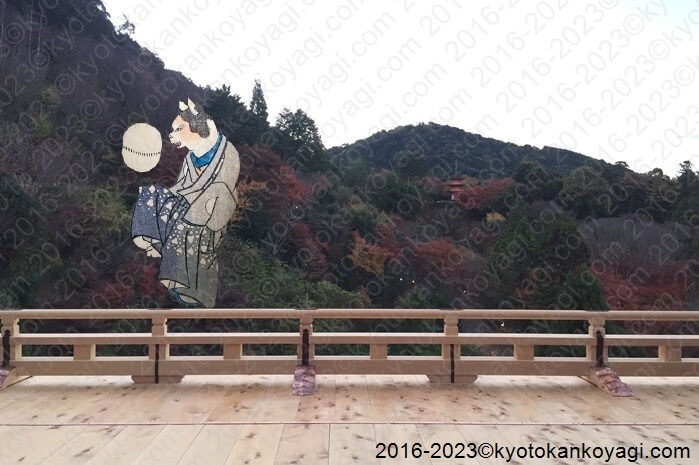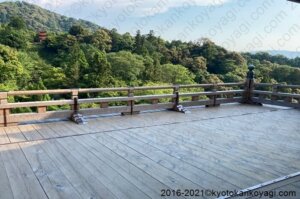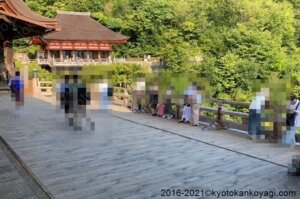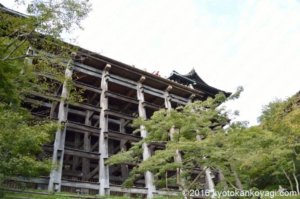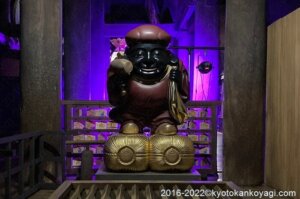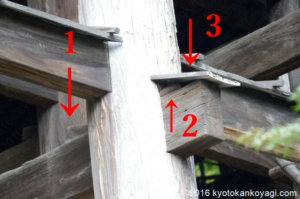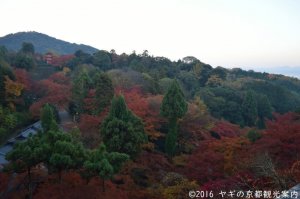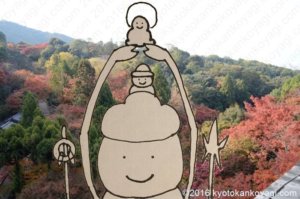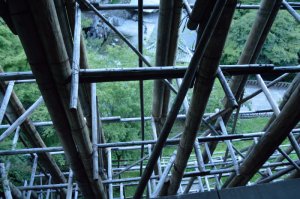THE GIST OF THIS ARTICLE
- Page 1 Intorduction, a short history of the stage
- Page 2 The construction of tha stage, Tobiochi Gankake
- Page 3 About Kiyomizudera, access, and bibliography
The following is the contents of this article.
The construction of the stage 舞台の構造
The stage 舞台
The stage is around 227 sq yds. Around 19 yd in length and 10 yd in width. The floor is made of the boards of Hiniki cypress. The board is around 5yd in length and around 2 ft in width. They are such huge ones and we can find in some places like Komyoin temple.
The height of the stage is around 42 ft and constructed in Kakezukuri (懸造) method with 78 pillars. It is a way to construct building over a valley and not indigenous to the stage. For example, Okunoin of Kiyomizudera temple is constructed in the same method.
The pillars 柱
The pillars are made of Japanese zelkova. The largest one of them is around 2.3 ft in diameter and 40 ft in length.

Behind Daikokusan, there are pieces of the old pillars.
Japanese zelkova doesn’t grow straight and it needs many years to have thick trees. To make the pillars, theses trees are cut as square prisms and they are cut into columns.
The thickest pillars are made of the trees over 400 years old.
Japanese zelkova can work twice of its age as a pillar. The stage was build in 1633. In 2023, it was 389 years ago. the pillars will work around 800 years.

In a nutshell, we have 400 years to go.
In 2000, the statue of Kannnon was open to us for the first time in 33 years. On the same year, around 3,000 Japanese zelkova trees were planted.

Some 400 years later, they will be the pillars of the stage that work over 800 years!
The pillars were repaird in 2013. The decayed foot of the pillars were replaced. It is called Netsugi (根継) method.
The pillars are settled on the stones, not stuck in the ground.

The pillars of the Japanese shrines and temples are just on the ground to prepare for earthquakes.
Nukis 貫(ぬき)
Each of the pillars are liked with Nukis.
The Nukis are stuck in the pillars. They are fixed with only wooden wedges as indicated as the arrow 1 and 2 because nails rust away. Nukis have “roofs” as indicated as the arrow 3.
The stage and Tobiochi 舞台からの景色を愛でつつ、願掛け飛び落ち
The valley is considered as Fudaraku Jodo (補陀落浄土) where Kannon rules.
In Japanese, When we do something with determination, we say “Jump off of the stage of Kiyomizudera.” It is a saying derived from some custom practiced on the stage.
In the 12th century, it was believed the end of the world was coming and Sutemi Ojo was in fashion. Sutemi Ojo is a self-inflicted death for the purpose to reborn in Jodo, the Buddhist paradise. As a part of it, people jumped off of the stage.
We have no exact idea how many times Sutemi Ojo was practiced until in the 17th century.
In Joujyuin Nikki, the diary kept by a monk of a sub-temple of Kiyomizudera tells us the precise information of Tobiochi Gankake from 1694 to 1864.
In this time, people practice Tobiochi Gankake to make their wishes come true not for fearing the end of the world. They creed is: If they are still alive on the ground, Kannnon helps to make their wishes come true, or she brings them to Fudaraku Jodo. Before jumping off, they visit the temple everyday to pray for Kannon.
In 171 years, Tobiochi was practices 235 times by 234 people. A person did it 2 times. The youngest is 12 years old and the oldest is 80 years old. 200 people succeeded and 34 person was diseased.

合掌
There used be lots of Sakura trees at the foot of the stage and they saved the life of the jumpers.
Jojuin and its neighbors were in charge of cleaning up the consequences. They asked the police office to make fences on the stage.
ヤギの京都観光案内/KYOTO GOAT BLOGをもっと見る
購読すると最新の投稿がメールで送信されます。

